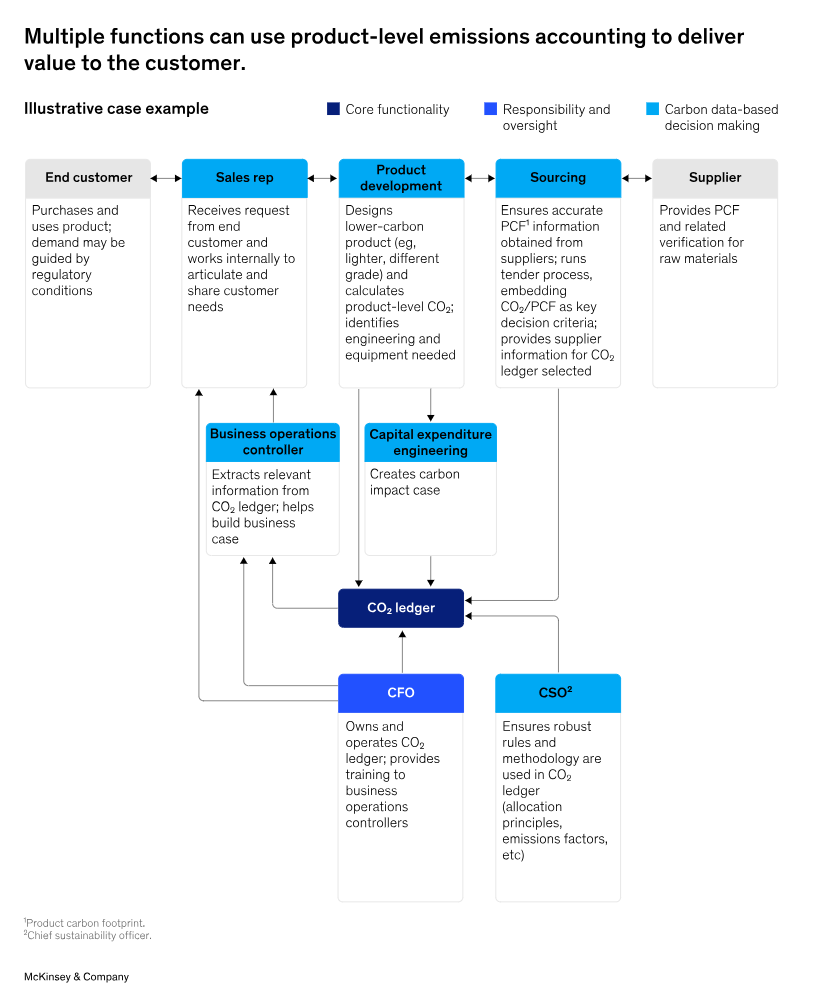Effective carbon management can deliver a competitive advantage. Here’s how global CFOs can move beyond “checkbox” compliance and move to strategic carbon decision-making.
Carbon emissions are a global challenge, but how each company responds to the risks and evaluates new opportunities should be determined on a case-by-case basis. While regulatory compliance is important, strategy is key.
CFOs need to ensure their organizations are meeting customer priorities, adapting to regulatory changes, and developing a comprehensive view of carbon management tools. Too often, companies can have inconsistent, ineffective, or even no meaningful emissions data at all.
In this article, we discuss how CFOs can help organizations assess the strategic importance of carbon and use emissions data to improve decisions.
The CFO's Challenge in Carbon Management
Across industries, sectors, and company sizes, CFOs not only ensure compliance and effective reporting, but also play a critical role in delivering on the organization’s core strategic goals. Carbon management is no exception.
For some companies, tracking and reporting carbon emissions is a necessity, a legal requirement, or both. In Europe in particular, regulators are demanding that companies not only disclose their emissions but also provide a level of assurance – just as they do with financial reporting. Failure to accurately report emissions can have financial and reputational consequences for companies around the world.
However, the optimal setting for carbon management is not necessarily “more is better”. Different markets have different regulations, including the quality of assurances that need to be provided. Climate disclosure regulations in the United States, for example, are still in a state of uncertainty. Investing in inappropriate processes and tools, for example, can waste a company’s resources, and forecasting price increases requires careful analysis.
Carbon management is very context-dependent: the challenges facing a software or biotech company in the United States are clearly different from those facing a steel, cement, or energy company in Europe, or a media company in the Asian market.

For a CFO – who sits at the intersection of strategy, reporting and resource allocation – it is critical to ensure that a company’s carbon management initiatives align with its strategic and compliance needs, while also meeting the demands of external stakeholders.
Many key customers across countries are eager to understand the carbon footprint of their products and are beginning to demand greater transparency in key metrics. Businesses that use robust carbon reporting can provide their customers with greater transparency and also help them identify new opportunities to develop differentiated green products.
The business case becomes even more compelling in stringent regulatory frameworks with global impact, such as the EU Carbon Border Adjustment Mechanism (CBAM).
Furthermore, CFOs can use carbon reporting to reduce the cost of emissions reduction. Not only can they focus on the most important emissions factors, but they can also make emissions reduction efforts more cost-effective by applying consistent metrics across the company and improving accountability across the organization.
Investing in more accurate and detailed data can also help improve discussions with suppliers; indeed, many leading companies in the value chain already require suppliers to disclose production-related emissions data, and consistent data makes it easier for suppliers to meet emissions targets.
And, most importantly, many investors will expect to have clear insights to understand the intrinsic value of a company under different carbon pricing scenarios. These analyses can only be done with robust carbon accounting.
Ultimately, carbon compliance can be more complex than one might think. The implications can extend beyond reporting emissions data to include carbon taxes, costs in emissions trading frameworks or carbon border adjustment mechanisms, and costs of voluntary carbon emissions reductions such as carbon credits.
Companies lacking detailed emissions data will have to rely on generic emission factors to estimate emissions across scopes. These estimates are often based on industry averages that are not tailored to the specific activities of each company (or its value chain partners) and do not fully reflect the latest industry innovations. Relying on generic frameworks may also be cost-ineffective.
For estimates on Range 3, rigorous value chain carbon accounting ecosystems such as the World Business Council for Sustainable Development’s Partnership for Carbon Transparency (PACT) can help improve the accuracy and reduce the cost of voluntary carbon credit portfolio targets aligned with the Science Based Targets Initiative (SBTi) criteria.
Define a vision for the finance function
Today, most companies do carbon accounting in a rudimentary way, which can limit their ability to stay ahead of regulatory developments and potentially create new value. Core initiatives are often run by sustainability teams rather than finance functions. And more importantly, carbon management can be driven more by regulation than strategy.
However, imagine a finance function where carbon accounting helps make better decisions. Finance teams would synchronize carbon accounting with financial accounting, using enterprise resource planning (ERP) systems to create a carbon or CO2 ledger that reflects the relevant financial accounts and accounting rules.
Finance teams will also prepare business performance indicators related to carbon budgets, intensity and target achievement, which will help other parts of the company make day-to-day decisions.
For example, if a company’s customer requires carbon emissions reduction in an aluminium product to mitigate the impact of the European Carbon Border Adjustment Mechanism, the sales team will pass this requirement on to the product development team and work with the finance function to build an integrated business case, ensuring significant added value for the specially adapted low carbon aluminium product.
Product development will design products using reduced material use and low carbon aluminum. Finance functions will support product carbon footprint (PCF) calculations and verification to align with the CO2 ledger. These functions will also support capital expenditure engineering to build sound business cases that reflect both the cost and carbon impact of required new equipment.
Sourcing teams will source suppliers that provide low carbon aluminium, ensuring that upstream PCF data on components and raw materials is verified and reflected in the CO2 ledger. Sustainability and finance teams will work together to ensure consistent accounting standards are used, internal and public reports are produced that are externally verified and audited, and overall impact on the profit and balance sheet, both financially and carbon-wise.
Over time, these ledgers will integrate with public carbon markets.

Turn vision into action
Effective CFOs turn vision into action, using clear data to support their decisions. When it comes to carbon-based decision-making, our experience shows that finance functions can gather clearer, sharper data and take practical steps now.
Specifically, they can drive consistency across the organization, improve internal processes, evaluate and implement the right ERP system, and help ensure that the finance function has the capabilities and level of cross-organizational coordination it needs.
Improve the process
When it comes to integrating internal operations with external reporting, the finance function has an advantage over other functions; finance professionals can draw on their experience working with accounting frameworks to meet existing and emerging emissions disclosure regimes. In practice, this means applying lessons from traditional financial accounting practices, such as establishing an annual process for setting emissions reduction targets, determining carbon offset targets, and budgeting for carbon reduction interventions and credits.
The accounting function understands the concept of disaggregated and tracked activities (in this case, carbon emissions) down to the transaction level, and in a standardized way (as pioneered by PACT), across all activities based on data sharing across the value chain. Furthermore, they can provide transparent emissions data and analysis across the organization to help managers make critical carbon-informed business decisions.
Implementing the right ERP system
While well-designed processes are essential to effective carbon management, companies will not achieve significant impact without the right ERP system. CFOs need sophisticated software solutions to process the flow of carbon information and aggregate it to make informed decisions. As Dominik Asam, CFO of SAP SE explains, “To make better decisions, CFOs need consistent data and metrics that connect directly to the company’s financial statements.
Businesses and functions within the organization produce disparate reports, use competing benchmarks, and generate data that lacks a clear strategic purpose. This defeats the purpose of an ERP system—which is to advance corporate strategy, not slow it down.”

Many companies are upgrading their ERP systems today for a variety of reasons, although carbon management is not the primary reason. However, given current regulatory and competitive trends, now is a great time to significantly improve carbon management capabilities. ERP systems can be complex and inflexible, which can complicate future updates and upgrades.
Therefore, companies will be best served by implementing carbon ERP in a modular manner (e.g. using APIs) to minimize system dependencies and allow for easy change in the years to come.
Several new and traditional vendors are betting that the rapid growth in demand for carbon accounting will lead to a thriving market for carbon ERP solutions.
Since investment decisions (whether sustainability-based or not) almost always involve trade-offs, choosing a solution that provides basic output from simple tools may be the best option. However, for companies looking to drive more informed carbon-based decision-making, the data stream will need to be more detailed and will likely become increasingly detailed in the future.
In fact, in our experience, asking which tool is right today is often the wrong question; instead, the goal should be to ensure the organization has a solution and vendor that can meet their needs over the long term.
Many incumbent ERP and transactional system vendors are looking to leverage their accounting expertise, integrated financial and carbon accounting systems, ecosystem synergies, and large customer bases to address more granular carbon accounting needs. Incumbent ERP vendors have an advantage: they already handle a large portion of the company’s data relevant to carbon accounting maturity, such as bills of materials, assets processed, and accounting and allocation rules.
A CFO will require company-specific functionality to help create differentiation opportunities, including overall carbon strategy ambition, regulatory requirements in operating countries, better understanding of a complex product, and cost-effective integration with existing ERP systems.
Overcoming procrastination
Moving from a finance and accounting orientation to one that includes carbon management can sometimes feel uncomfortable for CFOs. Because CFOs are typically focused on maximizing long-term profits – a mandate that is clearly linked to financial performance and reporting (though of course, accounting rules should not dictate strategy) – prioritizing emissions reduction can be a challenge.
As a first step, CFOs should define the company’s carbon accounting objectives: Why is carbon accounting important to this company? Is the goal to comply with regulatory standards, or are there material risks of failing to meet key stakeholder requirements or taking advantage of clear growth opportunities? It is important to ensure that voices outside of traditional finance and accounting are included in the discussion, as both the risks and opportunities may be greater than initially thought.
Among the actions to take, the CFO should outline what the company intends to achieve from improving its carbon footprint, assess disclosure requirements and the year by which the company must achieve reasonable assurance, and identify and prioritize use cases where carbon accounting can protect or create value.
From designing and measuring the impact of effective emissions reduction initiatives to making product-level claims for customer engagement and pricing, and guiding emissions-informed sourcing and procurement.
Next, CFOs should identify key gaps that need to be filled. For example, it is useful to map out how carbon accounting will be built and integrated into existing systems and processes; focus on what capabilities, skills, systems, and software may be lacking; and begin to identify and potentially select vendors to support carbon accounting and management, as well as the necessary auditing or validation service providers.
Finally, if the strategic rationale is compelling and the gaps can be filled in a value-creating way, CFOs should initiate implementation. This often requires the finance function to develop a specific roadmap that outlines the amount and timing of resource allocations to use cases. Capital allocation is not enough; talented employees need to be trained or recruited.
Emissions reduction efforts with the greatest impact across all scopes should be prioritised and implemented in customer contract negotiations and other agreements, to reflect the added value of emissions monitoring and support for purchasing carbon credits – including, where possible, for offsetting scope 3 emissions.
Carbon management sits at the intersection of strategy, compliance, finance, and technology. It’s a “hard problem,” and CFOs are uniquely positioned to help solve it. As regulatory standards become more stringent, customer demands increase, and new tools emerge, effective CFOs will help their organizations not only meet reporting requirements, but also identify when to integrate carbon management into decision-making to create value.
Source: McKinsey & Companyy
Monitor Bizzi To quickly receive the latest information:
- Facebook: https://www.facebook.com/bizzivietnam
- Linkedin: https://www.linkedin.com/company/bizzi-vietnam/
- Youtube: https://www.youtube.com/@bizzivietnam





